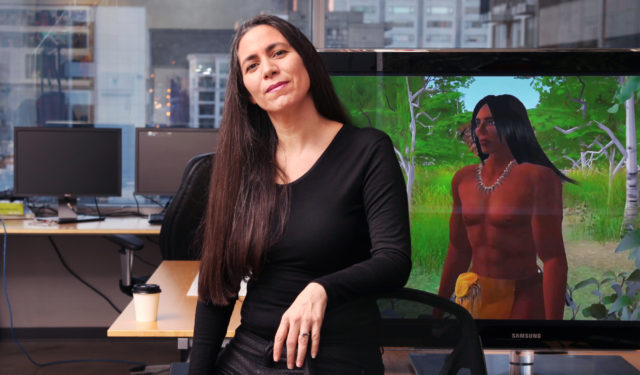Montreal based artist Skawennati was in Vancouver recently teaching a Skins Machinima Workshop. It was the first time the Aboriginal Territories in Cyberspace (AbTeC) Skins Machinima Workshop has been here.
Working in collaboration with the Museum of Anthropology(MOA), Living Labs/Emily Carr University of Art and Design(ECUAD) and the Initiative for Indigenous Futures(IIF). She has also begun work toward a new commission for 2017.
Six Indigenous youth currently participating in MOA’s Native Youth Program took part in the workshop.
I missed my opportunity to visit the workshop for a demonstration, however I did catch up with her back at home in Montreal. We had a virtual meeting on skype.
“The term Machinima, where does it come from?”
“It is a combination of machine and cinema combined to represent the two. It is a technique of making movies in virtual environments. The objective is to explore how oral storytelling traditions can be reimagined with new technologies.”
Within the span of a week, the workshop was able to achieve a completed story. I was privy to a link that featured a finished piece set in a virtual environment. The potential applications are exceptional.
Skawennati made her introduction to software design twenty years ago while in university.
She was in her third year of Fine Arts when a course, ‘the computer as a design tool’ was being offered.’
Primarily self-taught, she designed the Skins Machinima with her partner Jason E. Lewis (professor at Concordia University). He is also her partner in AbTeC. In the beginning stages of designing the workshop, they had consulted research students to come up with a curriculum as well as research game engines needed.
Considering there were a lot of game development companies in Montreal, they had decided to invite some game industry people to speak as mentors to the kids as well as Aboriginal mentors working in the video game industry. At that time, Skawennati expresses that their focus was more game design orientated. It has evolved since.
Although Skawennati enjoys traveling across Canada and introducing the workshops to the youth’s, she brought along two assistant’s on her last visit to Vancouver. One assistant had been through the Skins Machinima workshop and also enrolled at the Concordia University. It is her hope to eventually pass on the torch. In doing so, it would take much support and the formation of a team to sustain the success of the program. Laying down the framework could potentially take two years.
The costs associated with presenting each workshop is approx. fifteen thousand dollars.
The main purpose of bringing the workshops to the aboriginal youths is to empower them to be producers of media and just not consumers, and to show them that knowledge of their culture can be a valued asset in the video game/new media industry. It is also her hope for the workshops to inspire the students to eventually start up their own media companies in the future.
Growing up around video games, Skawennati noticed they were no indigenous people being represented. Given the current 2 D and 3D technology available, it could literally be a real game changer merging the Aboriginal stories and influences with game design.
They are ten partnerships across Canada involved in supporting and facilitating the workshops.
The ages of participation can vary from fifteen to twenty years of age. Skawennati has already begun to see a ripple effect. She knows personally of three university students from the workshops that were directly inspired to continue along the path of Computation Arts.
The workshops were originally 200 hrs long but they are constantly tweaking it and upgrading the game engine as the technology evolves. It is also intended to be a positive and encouraging experience rather than a mandatory one.
“Embracing technology does not mean you are less Aboriginal.” Skawennati really wants to change the stigma of advancing outside of native culture. She wants the youth to know that they can be astronauts and engineers. She finds it very worrisome that societies pressures can impact their choices and hinder their opportunities for a future working in the game design industry.
I found Skawennati very inspirational and the work her and Jason E. Lewis have put into the design of the Skins Machinima workshop has been nothing less than extraordinary. I whole-heartedly believe in the power of inspiration and the long lasting impact it can leave. A very rewarding legacy.



